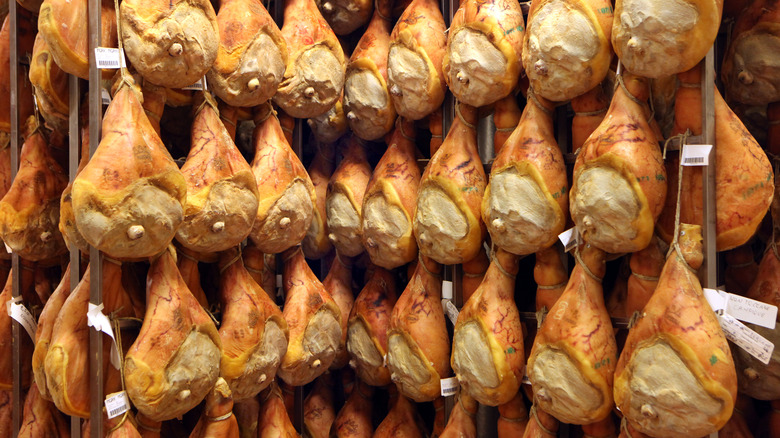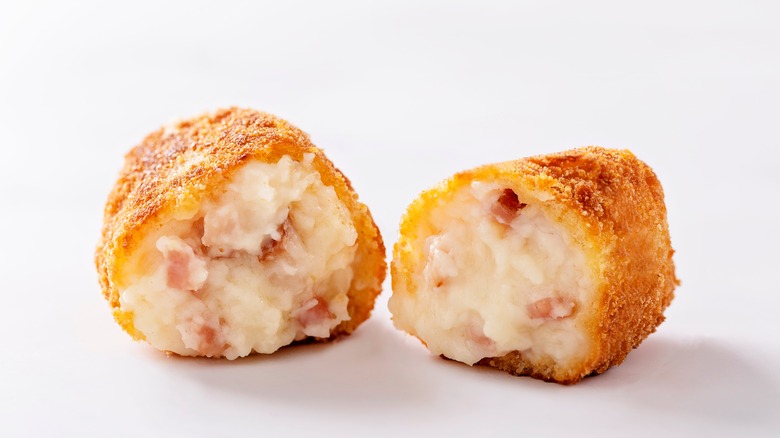The Difference Between Prosciutto And Jamón Serrano (And When To Use Each)
Charcuterie boards are all the rage these days, and it's no wonder. They're an easy-to-prepare crowd-pleaser that few party guests can resist, and they're infinitely customizable.
While any artfully arranged platter of meats and cheeses is practically irresistible, there are significant differences in the origin, quality, taste, and texture of cured meats. And knowing the difference can elevate an average charcuterie platter from ho-hum to heavenly. But with so many varieties in delis and grocery stores, it's hard to know which to choose, especially if you're pressed for time.
When you find yourself faced with an overwhelming number of options, you can rest assured that choosing Italian Prosciutto di Parma or Spanish Jamón Serrano will please even the most discerning foodies. Unlike thin cuts of ham found in most American delis, both are made from pork, salt, and water and are dry-aged to achieve richer flavors and a more delicate texture. But that's where the similarities end.
Different but equally delicious
Prosciutto, which means "ham" in Italian, is made throughout central and northern Italy. But prosciutto from the Parma region is especially sought after — hence its name, Prosciutto di Parma. It's made from the hind legs of pigs who are fed a special diet that includes chestnuts and the whey of Parmigiano-Reggiano cheese, giving the meat a nutty, salty, umami flavor. The meat is then aged for at least 1 year.
As chef and cookbook author Joanne Weir explained to Martha Stewart Living in 2020, Prosciutto di Parma is usually "pink in color and moist, with pure white fat around the edges and good marbling." If you prefer a prosciutto that's a little sweeter and fruitier, Prosciutto di San Daniele is a great choice. It's a deeper pinkish-red compared to Prosciutto di Parma, more aromatic, and according to Weir, a bit more "refined."
Jamón Serrano, meanwhile, is a type of Spanish cured ham, made from pigs fed a diet of grains. It's then salt-cured and aged for up to 18 months, yielding a meat that's "woody, intense, more gamy, and saltier in flavor than prosciutto, and redder in color," Weir explained to Martha Stewart Living. Jamón Serrano also has a slightly chewier texture. Jamón Iberico de bellota, which is aged for 36 months, is another highly-praised dried ham from Spain. It's made from Iberian free-range pigs fed a diet consisting primarily of acorns. (In fact, "bellota" means "acorn" in Spanish.)
Venturing beyond the charcuterie board
Both Prosciutto di Parma and Jamón Serrano will level up any charcuterie board. But their textures and flavors also make them easy, delicious additions to a variety of other dishes.
Because Prosciutto is already aged and cured, it's a simpler alternative to bacon; it doesn't have to be cooked (although it certainly can be). It works well in savory dishes, such as prosciutto parmesan quiche recipes. However, it also blends well with sweeter ingredients, as in this pear, prosciutto, and hazelnut stuffing recipe.
Jamón Serrano and other dried Spanish hams crisp up quickly in a hot pan, making them an easy way to amp up the meaty flavor in soups and salads, as well as a great addition to pasta carbonara. And if you ever get the chance, be sure to try one of Spain's most popular snacks: Spanish croquetas, which are small fritters made with jamón and béchamel sauce, coated in breadcrumbs and deep-fried.


